Family: Bufonidae (True Toads)
Genus: Anaxyrus (North American Toads)
|

| 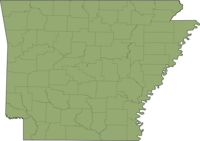
|
| Color variable, though usually a rusty-red. Skin dry with 1-2 warts per dark spot (some individuals without spots). Chest speckled with black. ⚠ Parotoid gland kidney-shaped and separated from eye ridge or attached by spur. Known to hybridize with other True Toads. Call a melodic trill. 
|
|

| 
|
| Color variable, though usually shades of brown. Skin dry with 3 or more warts per dark spot. Chest usually plain or with one breast spot. ⚠ Parotoid gland oval-shaped and touching eye ridge. Known to hybridize with other True Toads. Call a short "whaaat". 
|
|
|
|
Family: Hylidae (Treefrogs)
Genera: Acris (Cricket Frogs), Hyla (Holarctic Treefrogs), and Pseudacris (Chorus Frogs)
|

| 
|
| Small. Highly variable in color (browns, grays, greens, etc.) and pattern (plain, mottled, etc.). Back of head with darker triangular mark (not always obvious). Upper lip with 4-5 dark bars (not always obvious). Call cricket-like clicks, or as though two small pebbles were being chipped together. 
|
|
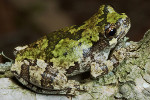
| 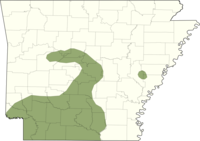
|
| Rare. Highly variable and can change colors, but usually shades of green and/or gray. Toe pads sticky. Skin smooth. Inside of legs yellowish-green. White spot under eye. Call bird-like with 2-5 whistles per second. 
| 
|

| 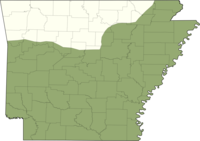
|
| Species of Gray Treefrog Complex (diploid). Highly variable and can change colors, but usually shades of green and/or gray. Toe pads sticky. Skin granular. Inside of legs bright yellowish-orange. White spot under eye. Call a fast trill. 
|
|

| 
|
| Color bright green with a prominent white stripe from upper lip to thigh. Toe pads sticky. Skin smooth. Call a duck-like quack. 
|
|

| 
|
| Rare with only a couple of confirmed localities in the vicinity of El Dorado. Color green or brown. Light ⚠ dorsal spots and vague stripe along the side may be present. Toe pads sticky. Skin smooth. Call a nasally, buzzing quack. 
| 
|
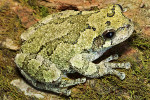
| 
|
| Species of Gray Treefrog Complex (tetraploid). Highly variable and can change colors, but usually shades of green and/or gray. Toe pads sticky. Skin granular. Inside of legs bright yellowish-orange. White spot under eye. Call a slow trill. 
|
|
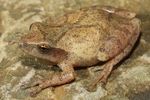
| 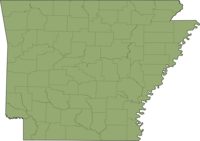
|
| Small. Color varying shades of tan and brown. Darker cross pattern on back. Toe pads sticky. Call in early spring a loud "peep". 
|
|
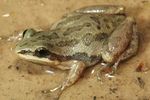
| 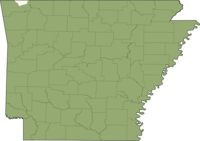
|
| Small. Color grays and browns. Dark stripe from snout to groin. 3 dark, thin (and usually broken) ⚠ dorsal stripes. Upper lip light. Call a "thumbnail raking a plastic comb" (from low to high pitch). 
|
|
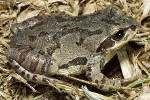
| 
|
| Rare (known only from extreme NE AR). Color grayish or tanish. Dark, irregular ⚠ dorsal blotches; sometimes very faint or not present. Dark stripe from eye to shoulder. Groin often yellow. Call a bell-like whistle.
| 
|
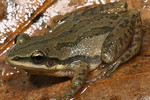
| 
|
| Rare with the only confirmed AR specimens from the vicinity of Pea Ridge, Benton County. Small. Color grays and browns. Dark stripe from snout to groin. 3 dark, thin (and usually broken) ⚠ dorsal stripes. Upper lip light. Call a "thumbnail raking a plastic comb" (from low to high pitch); noticeably faster pulse rate than P. fouquettei. 
| 
|
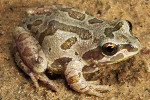
| 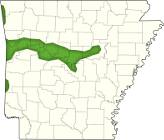
|
| Rare. Color grayish or tanish. Dark, irregular ⚠ dorsal blotches; sometimes very faint or not present. Dark stripe from eye to shoulder. Groin often yellow. Call a bell-like whistle. 
| 
|
|
|
Family: Microhylidae (Microhylid Frogs and Toads)
Genus: Gastrophryne (North American Narrow-mouthed Toads)
|
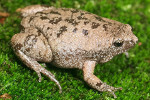
| 
|
| Small and squat. Mottled brown. Belly mottled black and gray. Head small and very pointed. Fold of skin behind eyes. Call a loud, long "baaaw of a dying sheep". 
|
|
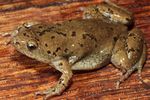
| 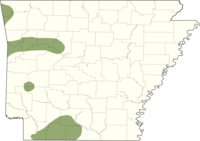
|
| Rare. Small and squat. Light gray (sometimes with a few small black specks). Belly plain. Head small and very pointed. Fold of skin behind eyes. Call a short "peep" followed by an "angry bee" buzz.
| 
|
|
|
Family: Ranidae (True Frogs)
Genus: Lithobates (American Water Frogs)
|

| 
|
| Rare. Large. Covered in large, dark spots ringed with light borders. ⚠ Dorsolateral fold. Call a loud, deep "snoring hog". 
| 
|
Subspecies: Southern Crawfish Frog (L. a. areolatus)  and Northern Crawfish Frog (L. a. circulosus) and Northern Crawfish Frog (L. a. circulosus) 
|

| 
|
| Rare. Background color shades of brown (never green) and always spotted like a "leopard". Spots round and random. Dark spot on snout. Light spot on ⚠ tympanum. Distinct light line on upper lip. Dark bars on back legs. ⚠ Dorsolateral fold broken near groin. Inside thigh yellowish. Call a series of 2-3 throaty "gulps".
| 
|
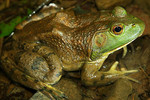
| 
|
| Very large as adult. Green or brown (usually rather patternless). ⚠ Tympanum large with fold of skin wrapping around it. ⚠ Dorsolateral fold absent. Call a low-pitched "bellowing bull". 
|
|
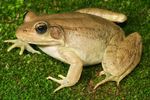
| 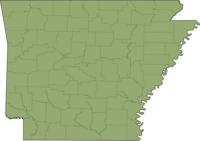
|
| Very large as adult. Green or bronze (usually rather patternless). ⚠ Tympanum large. ⚠ Dorsolateral fold present. Call a "loose banjo string". 
|
|

| 
|
| Metallic-like sheen. Light gray, tan, or yellowish background with leopard-like dark spots. Spots on back squarish and paired. Dark bars on back legs. Inside thigh yellowish. ⚠ Dorsolateral fold. Call a quiet, low-pitched, 1-2 second "snore".
|
|

| 
|
| Color shades of green or brown and always spotted like a "leopard". Spots round and random. No dark spot on snout. No distinct spot on ⚠ tympanum. Light line on upper lip. Dark bars on back legs. ⚠ Dorsolateral fold not broken (or, if broken, in the same line). Inside thigh not yellowish. Call a series of quiet "chuckling quacks". 
|
|
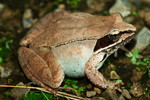
| 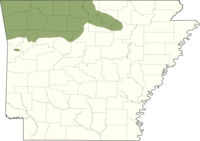
|
| Rare. Tan with a distinctive black "mask" and light upper lip. ⚠ Dorsolateral folds. Call a quiet "hoarse duck". 
| 
|
|
|
Family: Scaphiopodidae (North American Spadefoots)
Genera: Scaphiopus (North American Spadefoots) and Spea (Western Spadefoots)
|

| 
|
| Rare. Color variable, but usually brownish. Two light ⚠ dorsal lines. Skin moist. ⚠ Parotoid glands not obvious. No raised bump between eyes. Eye pupils vertically elliptical. Dark "spade" on bottom of foot long and sickle-shaped. Call a loud "grunt".
| 
|
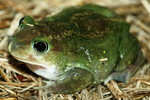
| 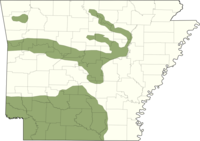
|
| Rare. Color variable, but usually greenish. Two light ⚠ dorsal lines. Skin moist. ⚠ Parotoid glands not obvious. Raised bump between and slightly behind eyes. Eye pupils vertically elliptical. Dark "spade" on bottom of foot sickle-shaped. Call a loud "grunt". 
| 
|
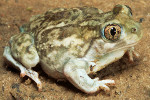
| 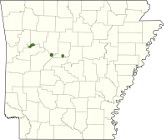
|
| Rare with only 4 known localities in AR. Color grayish or bluish with small, red spots. Skin moist. ⚠ Parotoid glands not obvious. Raised bump between eyes. Eye pupils vertically elliptical. Dark "spade" on bottom of foot rounded. Call a short "snore". 
| 
|
|
|
~ Potential Occurrence ~
|

| 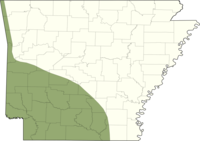
|
| Hybridizes readily with other True Toads and a pure AR specimen may not be obtainable. Color variable, though usually grayish. Skin dry with the number of warts variable (1 or more) per dark spot. Chest usually plain. ⚠ Parotoid gland oval-shaped and touching eye ridge. Known to hybridize with other True Toads. Call a short "whaaat".
|
|

| 
|
| Rare with no known breeding populations in AR. (Single vouchered specimen from Union County was likely the result of stocking a lake with fish from Louisiana.) Color variable, but with dark ⚠ lateral stripe bordered above by light stripe. Skin dry and warty. Parotoid glad triangular with eye crests forming a deep crease on head. Call a series of "wooden rattle" trills.
|
|

| 
|
| Rare with no vouchered specimen for AR. Background color a shade of gray or green. Spots typically green and bordered in black. Usually a triangular-shaped spot behind eyes. Call a rasping "rrrack-rrrack-rrrack".
|
|

| 
|
| Rare with no vouchered specimen for AR. Small. Color grays and browns. Dark stripe from snout to groin. 3 dark, thin (and usually broken) ⚠ dorsal stripes. Upper lip light. Call a "thumbnail raking a plastic comb" (from low to high pitch); noticeably faster pulse rate than P. fouquettei.
|
|
|
|
|
|
⚠ (:flickrgallery tags="Frog_Unidentified":)
|